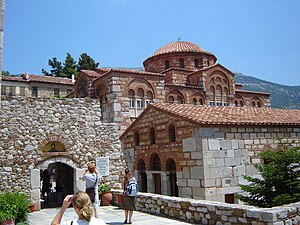| Monasteries of Daphni, Hosios Loukas and Nea Moni of Chios* | |
|---|---|
| UNESCO World Heritage Site | |
 | |
| State Party | |
| Type | Cultural |
| Criteria | i, iv |
| Reference | 537 |
| Region† | Europe and North America |
| Inscription History | |
| Inscription | 1990 (14th Session) |
| * Name as inscribed on World Heritage List. † Region as classified by UNESCO. | |
Hosios Loukas (Greek: Ὅσιος Λουκᾶς) is an historic walled monastery situated near the town of Distomo, in Boeotia, Greece. It is one of the most important monuments of Middle Byzantine architecture and art, and has been listed on UNESCO's World Heritage Sites, along with the monasteries of Nea Moni and Daphnion.
History
The monastery of Hosios Loukas is situated at a scenic site on the slopes of Mount Helicon. It was founded in the early 10th century by the hermit St. Lukas, whose relics are kept in the monastery to this day. The hermit (who died on 7 February 953) was famous for having predicted the conquest of Crete by Emperor Romanos. It was unclear if he was referring to Romanos I, the emperor at the time. However the island was actually reconquered by Nicephorus Phocas under Romanos II. It is believed that it was during the latter's reign (959-963) that the Church of the Theotokos (Panagia) was constructed.
The main shrine of the monastery is the tomb of St. Lukas, originally situated in the vault, but later placed at the juncture of the two churches. The monastery derived its wealth (including funds required for construction) from the fact that the relics of St. Lukas were said to have exuded myron, a sort of perfumed oil which produced healing miracles. Pilgrims hoping for miraculous help were encouraged to sleep by the side of the tomb in order to be healed by incubation. The mosaics around the tomb represent not only St. Lukas himself, but also hegumen Philotheos offering a likeness of the newly-built church to the saint.
Architecture
The church of the Theotokos, the oldest in the complex, is the only church known to have been built in mainland Greece in the tenth century.[1] This centralized parallelogram-shaped building is the oldest example of the cross-in-square type in the country; its plan closely follows that of Fenari Isa Camii in Constantinople. The walls are opus mixtum (part brick, part stone, part marble) and display curious pseudo-kufic patterns.
The Church of the Theotokos adjoins a larger cathedral church, or the Katholikon, tentatively dated to 1011-12. The Katholikon is the earliest extant domed-octagon church, with eight piers arranged around the perimeter of the naos. The hemispherical dome (without a drum) rests upon four squinches which make a transition from the octagonal base under the dome to the square defined by the walls below.[2] The main cube of the church is surrounded by galleries and chapels on all four sides.
Decoration
Hosios Loukas is the largest of three monasteries surviving from the Middle Byzantine period in Greece. It differs from the Daphnion and Nea Moni in that it is dedicated to a single military saint. St. Lukas's prophecy about the reconquest of Crete is commemorated by the image of Joshua on the exterior wall of the Panagia church: Joshua was considered a model "warrior of the faith", whose help was especially effective in the wars waged against the Arabs. The Katholikon contains the best preserved complex of mosaics from the period of the Macedonian Renaissance. However, the complex is not complete: the original image of Christ Pantocrator inside the dome is missing, as are the figures of archangels normally placed between the upper windows.
There is evidence that the monastery was reputed all over Byzantium for its lavish decoration, liberally applied to all surfaces. Apart from revetment, carving, gold and silver plate, murals, and mosaics (especially imposing on curving surfaces), the interior featured a choice assortment of icons, chandeliers, silk curtains, and altar cloths. Only a fraction of these items are still in situ, most notably colored marble facings and window grilles. Notwithstanding the losses, the Katholikon "gives the best impression available anywhere today of the character of a church interior in the first centuries after the end of Iconoclasm".

No comments:
Post a Comment